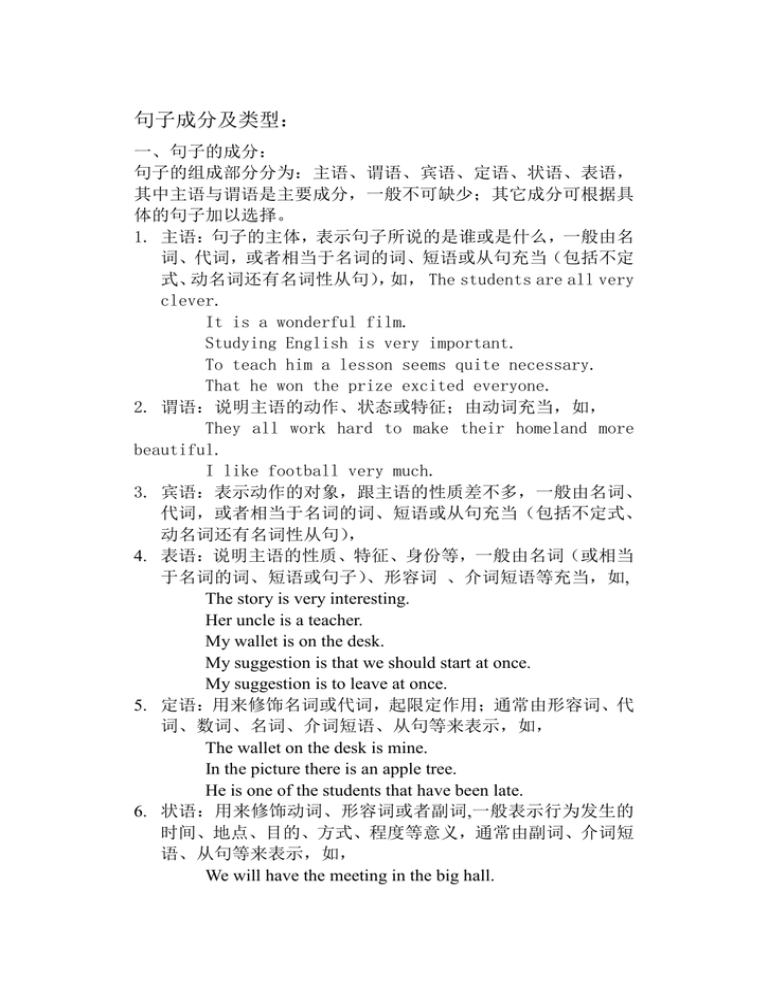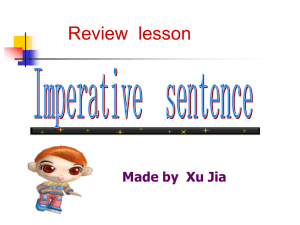句子成分及类型:
advertisement

句子成分及类型: 一、句子的成分: 句子的组成部分分为:主语、谓语、宾语、定语、状语、表语, 其中主语与谓语是主要成分,一般不可缺少;其它成分可根据具 体的句子加以选择。 1. 主语:句子的主体,表示句子所说的是谁或是什么,一般由名 词、代词,或者相当于名词的词、短语或从句充当(包括不定 式、动名词还有名词性从句),如, The students are all very clever. It is a wonderful film. Studying English is very important. To teach him a lesson seems quite necessary. That he won the prize excited everyone. 2. 谓语:说明主语的动作、状态或特征;由动词充当,如, They all work hard to make their homeland more beautiful. I like football very much. 3. 宾语:表示动作的对象,跟主语的性质差不多,一般由名词、 代词,或者相当于名词的词、短语或从句充当(包括不定式、 动名词还有名词性从句), 4. 表语:说明主语的性质、特征、身份等,一般由名词(或相当 于名词的词、短语或句子)、形容词 、介词短语等充当,如, The story is very interesting. Her uncle is a teacher. My wallet is on the desk. My suggestion is that we should start at once. My suggestion is to leave at once. 5. 定语:用来修饰名词或代词,起限定作用;通常由形容词、代 词、数词、名词、介词短语、从句等来表示,如, The wallet on the desk is mine. In the picture there is an apple tree. He is one of the students that have been late. 6. 状语:用来修饰动词、形容词或者副词,一般表示行为发生的 时间、地点、目的、方式、程度等意义,通常由副词、介词短 语、从句等来表示,如, We will have the meeting in the big hall. Why not go with us since you have enough time? *补语: 以上的都是句子的组成部分,而补语则是从句子的从含 义上说而引申出的一个概念,是对原来意义的一种补充,表语、 状语、同位语等有时都可以看作是一种补语,如, He is right over there, watering the flowers. Nobody can change my mind, including my parents. 二、句子的分类: . 交际功能上:陈述句、疑问句、祈使句、感叹句 1. 陈述句;用来说明事实或者说话人看法; 2. 疑问句: A. 一般疑问句:对某一情况是否事实提出疑问,一般用 YES, 或 NO 来回答,有两种形式: be/have+主语…..? 助动词(情态动词)+主语+行为动词……? B. 特殊疑问句:用疑问词(what, who, how, why, when, where…)提问,一般有两种结构, 疑问词+一般疑问句型结构,what are you doing? 疑问词做主语或主语的定语时用陈述语序, what is your name? C. 反意疑问句:表示提问者有一定的主观看法,但没有把握, 希望对方来证实;有四种形式:前肯定后否定、前否定后 肯定、前后都肯定、前后都否定,较为常用的为两种:前 肯定后否定、前否定后肯定。 *注意要点: ①反意疑问句的回答应该以事实为依据,而不能依照中文的 习惯回答,如, ------He isn’t a student, is he? ------NO. He isn’t.(是啊,他不是学生。) / Yes. He is.(不, 他是个学生。) ②注意反意疑问句否定提前时的情况,如, I don’t think he is honest, is he? ③一般来说句子里包含表示否定的副词,反意疑问部分选用 肯定式; 如果包含的是表示否定的动词则不遵循此原则,如, He has never been to the US, has he? He dislikes such a man, doesn’t he? ④如果反意疑问句的构成形式为:主语+表示想法的状态动词 +宾语从句,那么如果主句主语为第一人称,反意疑问的为宾 语从句的主语;如果主句的主语为二、三人称,那么反意疑 问的为主句的主语,如, I don’t think he is honest, is he? You all know that he is honest, don’t you ? ⑤THERE BE 句型反意疑问的主语一般为 there, 如, There used to be a tall building here, usedn’t there?/ didn’t there? ** 英语口语里面还有一个句型用的比较多,往往为 “(主语) 祈使句…,+will you?”,往往表示一种建议、命令、恳求等,跟 反意疑问句有点象,如, Open the door, will you? You clean the floor today, will you? Those boys over there please come here, will you? D. 选择疑问句:形式上与一般疑问句相似,但里面包含两个 答案,用“OR”连接,不能简单用Y/N回答,如, Are you from Scotland or England? 3.祈使句:表示命令、恳求、禁止等,语气较强;主语通常为第 二人称,而且通常省略,如, Don’t be afraid./ Be careful. 以LET引导的句子也是祈使句,常用于第一和第三人称,表示 建议,如, Let him go as soon as possible. Let me help you. 4. 感叹句:表示喜怒哀乐等强烈感情色彩,由 what, how 引导的 成分放句首,其后跟陈述语序。 A. how 做状语,修饰形容词、副词或者动词,如, How wonderful the film is! How hard he works! How I wanted to see you! B. what 做定语,修饰名词,单数名词前加不定冠词;在口语 中常用省略句: What a beautiful picture (it is)! What fine weather! 句子的结构:简单句、并列句、复合句 1. 简单句:只包含一个主谓结构的句子(有时可以有并列主语或 并列谓语); 简单句的五种常见结构; 主语+系动词+表语; 主语+谓语; 主语+谓语+宾语; 主语+谓语+间接宾语+直接宾语;(双宾) 主语+谓语+宾语+宾补;(复合宾语) 存在句(THERE BE 句型一般也可算是一种简单句,是一种 倒装而已),如, There is a taxi right over there. 2. 并列句及常见的并列连词; 并列句由简单句+并列连词+简单句构成,常见的并列连词有 and, but, or, (for, so) not only…but also…, either…or…等 It is raining outside, so we will stay at home. He couldn’t go to school, for he was poor.
![[3]句式功能的再现](http://s2.studylib.net/store/data/005282478_1-f4b8e20306b01619e585e273f522dec7-300x300.png)


